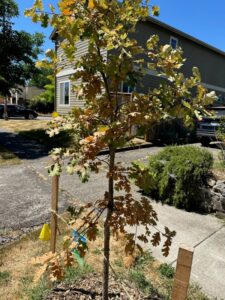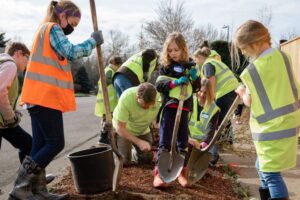Tag: tree care
Are your trees getting enough water?
Watering tips from the Eugene Team
This July didn’t hesitate to remind us just how hot it can get in an Oregon summer, with five consecutive days with highs over 100° Fahrenheit. And while many of us are lucky to be able to find shelter from a heatwave, trees don’t have that same luxury. For young trees in particular, extreme heat can cause tremendous stress and threaten the trees’ survival.
“It’s around this time every year when we start getting a steady flow of concerns about the well-being of young trees,” says Eugene Director Erik Burke. “Trees can dry out in just a couple days in a heatwave. There are a lot of factors that go into it, including the species and the site conditions.”
Trees that are getting too much water or not enough water can show similar symptoms. Most notably, their leaves will start to brown and curl. In most instances that a tree is getting too much water, it’s because the resident has lawn irrigation systems. It’s more common that a tree is under-watered.
“It can be hard for people to apply enough water,” Erik says. “Sometimes I see people misting the ground beneath their tree with a hose and then walking away. And there wasn’t even enough water to penetrate the soil.”
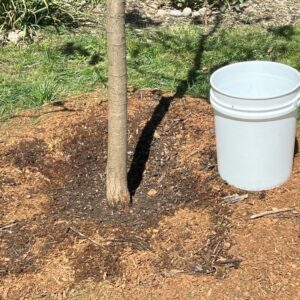
Trees need deep weekly watering during hot dry summer months: 10 to 15 gallons of water around the base of the tree. It’s important to imagine where the roots are. You want the water to be reaching through the soil to the ends of those roots. It’s also good practice to water in the morning or the evening when you’ll lose less moisture to evaporation. A thick layer of mulch will help retain moisture in the soil.
During a heatwave, your tree might need to be watered more often than once a week, but how do you know if it’s time to water? You can test the soil! There are inexpensive soil moisture readers available at hardware stores, or you can use something you have readily on hand, like a pencil or a stick.
“It’s like testing a cake to see if it’s done,” says Taylor Glass, our Eugene Springfield Program Manager. Insert your pencil several inches into the soil. When you pull it back up, if soil has stuck to the pencil then it still has moisture and you don’t need to water just yet. If it comes up dry you can go ahead and water your trees. Different soil types will dry out faster than others, so it’s important to check regularly and get to know your tree’s particular site.
“Some trees will suddenly torch, that is, get really dry and stressed,” Erik says. “As soon as you see that, you just want to water the heck out of it. Every species has a different tipping point.”
Some species like the Oregon ash or California buckeye will call it quits for the year when the soil gets dried out in August and just drop their leaves. When they come back next year they’re totally fine. But other trees won’t survive.
To help new tree owners take care of their trees, Friends of Trees sends out volunteer summer inspectors. For the first three summers of a tree’s life it will get two visits. The inspector will check on the tree’s well-being, look for any issues or concerns, and check the soil to see if there’s enough moisture.
“It’s a really fun role,” Taylor says.” You get to learn about trees while walking or biking around your neighborhood.”
With heat waves becoming more and more common, we need trees and the shade they provide to keep us cool. We need to return the favor and make sure we take care of trees so that they can survive and thrive.
Preparing Eugene Trees for Climate Change
What we can do in the face of an uncertain future
When it comes to trees, there are so many layers to preparedness, from the near to distant future, from the next heat wave or ice storm to what the climate might look like in 25 years. So much of the future is uncertain, but there’s plenty you can do to prepare your trees for what they might encounter.
“So much is unknowable,” says Eugene Director Erik Burke. “You won’t have the information you need to make your decisions when you make them. You just have to make your best guess.”
The very first decision you’ll make is what tree to plant. Considering trees that are adapted to your climate, and what the climate might be in the future, can set your tree up for a long, healthy life.
“For a while, the estimate was that by 2050, Eugene’s climate might be like Sacramento’s is now,” Erik says. “But that estimate is moving even further south to Stockton.”
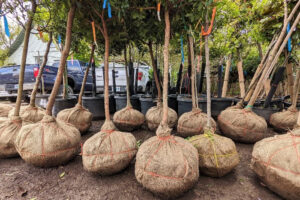
Erik outlines three approaches that planting programs can take to prepare for climate change. The first is diversity for diversity’s sake. Planting a variety of trees means that if any particular species fails due to climate impacts or disease, it won’t take out a huge chunk of the urban forest. The second is very intentionally looking at trees adapted to our native climate and soils, but many of those species aren’t readily available in the nursery trade. The third is planting broadly adapted trees with huge ranges, but many of those trees aren’t drought tolerant, and because many of those trees are clones, they aren’t given the opportunity to adapt from generation to generation.
“Really, we should do some of each approach,” Erik says. “There are trade offs for each.”
What about trees that are already in the ground? How do we prepare our large trees? Our Eugene Team always emphasizes the importance and value of regular pruning. Appropriate pruning will set a tree up to survive in the urban environment and in the face of weather events.
“It’s important to remember that stress is additive. Even if a tree survives, stress can pile up from heat wave to ice storm to heat wave.” Erik says. “That’s why we need to water during heat waves and prune properly after ice storms.”
How we respond to storms is the first step in preparing for the next one. Erik warns that bad pruning after an ice or wind storm can lead to more failure down the line, because limbs won’t be strong enough for the next. Still, he advocates for proper pruning after storm damage rather than removing a tree.
“When you remove a tree, you’re back to square one. But restorative pruning can give that mature tree a chance to continue providing benefits.”
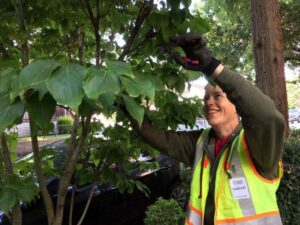
Selection, siting, pruning, protecting soil, and public education. This is how we reach what Erik calls our ultimate goal: to have a healthy relationship with trees. That’s why it’s important to find opportunities to talk about trees.
“Weather and climate is something everyone experiences,” says Taylor Glass, Eugene-Springfield Program Manager. “It’s something to connect over. It’s a way to talk about climate change.”
“My hope is that it will cause us to cooperate more,” Erik says.
“We’re going to have to,” Taylor says.
Together we can protect trees and our communities: Friends of Trees Op-Ed
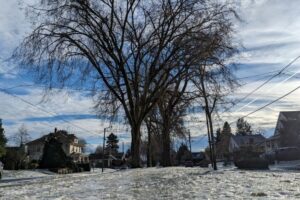
On January 21st, The Oregonian published an op-ed written by Yashar Vasef, our executive director, and Litzy Venturi, our community tree care coordinator: “We must invest in tree care to protect trees and our communities.” Read the full piece below.
Opinion: We must invest in tree care to protect trees and our communities
Climate change and its severe impacts force us to live with dual realities: We need trees more than ever and we need to recognize that extreme weather can turn them into hazards. After hundreds of trees and large limbs fell around the Portland metro area during this historic winter storm, we know that people may be concerned about the trees in their neighborhoods. The impact of a downed tree is serious and often devastating.
The response is clear, but not necessarily easy. Not only do we need to continue to plant trees to grow our urban canopy, but we also need to invest more time, knowledge and resources into assessing, protecting and maintaining the trees we have. As part of that, we must also deal with trees that need to be removed and replaced due to poor health or the potential threat they pose to homes or businesses.
Trees are a crucial ingredient for a healthy, resilient and livable community. How do we set our trees up for success in the face of potential extreme weather? It starts with planting the right tree in the right place. Sometimes people favor certain species because of sentiment or aesthetic appeal, but if they aren’t planted in a place with the right conditions, they’re more prone to failure. Selecting a tree for the available space, light and soil type is the first step in giving a tree a long healthy life.
The next step is to invest in caring for young trees after they’re planted. Proper watering techniques encourage roots to spread into a wide, stable network. Mulching around a tree’s root zone provides the soil with needed nutrients and structure. The right pruning plan will allow a tree to establish a strong trunk and a stable shape and mitigate the risk of limb failure. Tree care is a lot like preventative medicine. Keeping a tree healthy will reduce the risk of catastrophic failure.
You might be looking at a large tree in your own yard and wondering what to do next. While concern after this winter storm is natural, it’s important to remember that the benefits of trees far outweigh the risks. Trees create oxygen, abate pollution and cool our neighborhoods. It’s important not to over-correct by removing healthy trees. This was an unusually catastrophic weather event, and while hundreds of trees fell, millions didn’t. Still, there are steps you can take as a tree owner, and that we can take as a community, to better care for our trees and reduce the risk of catastrophe in the future.
An arborist partner of ours, Chad Honl, pointed out in a recent Oregonian/OregonLive story that this was “a perfect storm for knocking over trees,” and that even trees he would have characterized as stable toppled over in the storm. That’s a scary prospect, especially as climate change increases chances for extreme weather. But it just means that we need to learn more about what happened – which kinds of trees fell and what factors may have made some more vulnerable to failing than others. We agree with Honl’s call for trees to be assessed and reassessed with storms like this in mind. Understanding and addressing risks in advance of the next storm can save a lot of money, trouble and even lives. If you’re worried about your tree, you should have it inspected by a certified arborist for maintenance needs and potential problems.
A greater investment in trees doesn’t just mean planting more trees. It means taking care of the trees we have. In response to the unexpected revenue from the Portland Clean Energy Fund, Portland City Commissioner Carmen Rubio has called for additional climate investments, including $100 million for the protection and maintenance of 240,000 right-of-way street trees between the sidewalk and the street. We need to protect our mature trees and protect our communities by making sure those trees are safe.
The more mature a tree gets, the more benefits it provides: more carbon storage, more air and water quality benefits, more shade, more habitat. That’s why we need to invest in the health of our trees, for our safety in the event of a winter storm or heat wave, for our daily mental and physical well-being, and for the health of the planet.
Returning to a Natural Area in Springfield
Can I get a refill?
Next month, volunteers will be planting trees, shrubs, and understory near a major intersection on the Bob Straub Parkway in Springfield. But they won’t be starting from scratch—this location has already been the site for four planting events in the past six years. You’ve heard us say it before at Friends of Trees, we don’t just plant and walk away. But what exactly does that mean? It means post-planting care, stewardship training, and in the case of many natural area plantings like this one, it means infill planting.
Infilling is sort of like refilling, not that this site is empty. Thanks to enthusiastic past volunteers who planted it and neighbors of the planting site who have protected it, it’s already a beautiful spot.
“This is one of our most successful Green Space plantings,” says Eugene Director Erik Burke. “It’s in the floodplain, and it has really good soil. Overall, things are growing really well.”
That doesn’t mean that the site isn’t worthy of some replanting. At natural area plantings like this one, we plant in pods that have multiple levels: trees, shrubs, and herbaceous understory with things like milkweed and camas. At the Bob Straub planting site, a few trees need to be replaced and some of the shrubs and flowers could use some support.
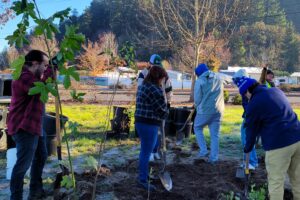
“We really want to create a rich, robust planting area,” Erik says. “It’s so satisfying to create these dense clusters of plants.”
We plant these pods similar to the Miyawaki Method, which aims to mimic how a forest would rebuild itself if people stepped away. It’s all about establishing a community of trees and plants, which is fitting because a community of people plant it, care for it, and benefit from it.
“Like with all of our plantings, it’s important to make sure that they have a lasting impact,” Erik says. “That’s why we return.”
Show Your Trees Some Tree-LC
Caring for trees of all ages creates the diverse urban forest we need!
Sometimes trees need a little tree love + care. When we take care of our trees, we help them take care of us. This is the beautiful relationship between trees and community that is at the core of Friends of Trees. You can help foster and expand your community of tree stewards.
Because we are a tree-planting organization, we usually focus on young tree care. As our Community Tree Care Coordinator Andrew Land puts it, “we’re really in the business of pediatric arboriculture stewardship training.” That mouthful of words aside, we focus on young trees getting the care they need so that they can survive to be mature trees.
“We often talk about how important it is to have a diversity of tree species,” Andrew says. “It’s also really important that we have a diversity of tree ages. Trees planted at the same time will theoretically time out at the same time.”
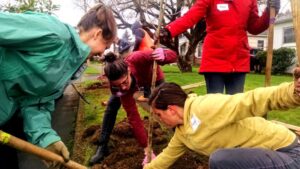
While it’s important that we plant and develop our urban forest, it’s also important that we nurture and maintain. It’s not one or the other. It has to be both.
“When we talk about the public health benefits of trees, we’re really talking about mature trees,” Andrew says. “The benefits of a tree—like its ability to clean air and water—expands exponentially each year.”
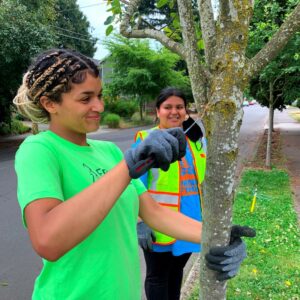
This is why we don’t just plant trees and walk away. So what are some of the things you can do to take care of your trees? We encourage you to make a tree care plan for all your trees, no matter how old. The right attention over the years can maximize the life of your tree and the benefit it provides.
For the first few establishment years, proper watering and mulching are crucially important. After that, trees are relatively low maintenance, but you should still make sure to do regular inspection and maintenance pruning every few years. Maintaining a healthy mature tree provides so many benefits to you and your whole neighborhood.
“One of the best things you can do is simply notice,” Andrew says. “Notice how the trees at your own home are doing. Notice how your neighbors trees are doing. Talk to your neighbors about their trees.”
For example, if you see a particularly special mature tree, talk to the owner about nominating it for special status and protections, like the Portland Heritage Tree Program.
Together, we can’t plant so many trees in just a single Saturday morning. Tree care can be a lifelong mission. Check out some resources here.

